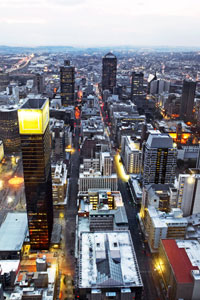Pairing a gold rush legacy with a metropolitan vibe, Johannesburg – Joburg or Jozi to its friends – is rugged, chaotic and strangely irresistible. The eyes of the world gazed keenly at the city last month as host of the opening game and final match of the FIFA World Cup, and because of the security strikes that brought the diverse and discordant nature of the city into focus.
It’s a place where poor townships border grey skyscrapers and glitzy shopping malls. Streets are jammed with hectic taxi drivers ignoring all traffic signs and lanes. People are everywhere, bringing the rugged jewel to life. It is home to some of South Africa’s most diverse cultural experiences, best restaurants and nightlife, and most savage reminders of the oppression of apartheid.
Downtown Joburg combines all three. The Market Theatre (56 Margaret McIngana Street, www.markettheatre.co.za) is South Africa’s ‘Theatre of the Struggle’ – a cultural haven established in 1976 that actively challenged the apartheid regime, convinced that its work could change society. Today it is a multi-venue complex for theatre, music, dance and the allied arts, showcasing home-grown talent.
A tour around nearby Market Street is a fine introduction to the city’s history. The Rissik Street Post Office is one of the city’s grand landmarks, while further along is the Guildhall Pub. Probably the city’s oldest drinking hole, it has sat on the edge of Johannesburg’s original market square since 1888 – just two years after gold was discovered on the Reef. The areas of Ferreirasdorp and Marshalltown are the original city’s centre, and feature an impressive mix of architecture, including art deco buildings and more modernist styles.
Out west is Soweto, South Africa’s biggest township and home to a million blacks, where many of the country’s political battles were fought. The streets of the booming township are simultaneously home to the country’s growing number of millionaires and the most desperately poor. Soweto’s Vilakazi Street is the only street in the world with the homes of two Nobel Peace Prize winners: President Nelson Mandela and Archbishop Desmond Tutu. The former’s house there is now a museum full of his personal artefacts, and long-term residents of the township offer guided tours, explaining the stories behind each point of interest.
The Apartheid Museum in Booyens Reserve is Johannesburg’s hard-hitting testament to its brutal history. Visitors are arbitrarily assigned a racial identity, and are only permitted access to the museum through the appropriate segregated gate. The provocative and often emotional exhibits take a good few hours to navigate and digest.
But Joburg isn’t all horrible histories. The trendy suburb of Melville in the western part of town is well known for its coffee shops, restaurants and lively nightlife. The bohemian 7th Street offers a range of venues catering for all tastes and ages. Buzz 9 is one of the most popular restaurants/cocktail bars in Melville, while the Mezzaluna restaurant serves delicious lamb, oxtail and salmon.
The Sophiatown restaurant (www.sophiatownbarlounge.co.za) is inspired by the suburb of the same name. During the 1940s and 1950s, Sophiatown became the centre of black culture in Johannesburg and the hub for arts, politics, religion and entertainment. The restaurant is in Newtown, Joburg’s cultural precinct, and offers a menu including crocodile, kudu and ostrich, with Afropop and live jazz entertainment.
Arts on Main (www.artsonmain.co.za) is a unique blend of shops and galleries tucked away in a converted warehouse in the heart of the city. The century-old building is home to local bohemians and pays tribute to the city’s efforts to regenerate old historic sites and attract residents back to the centre of the metropolis. More crafts and curios can be found at the rooftop market in Rosebank, including masks, fabrics, sculptures and simple souvenirs – but be prepared to haggle heavily. Spices, homemade food and local music are also available, offering visitors the chance to take the flavours and feel of the city home with them.





